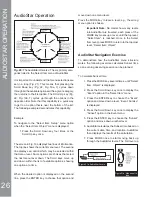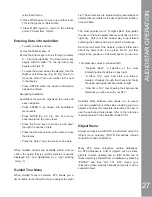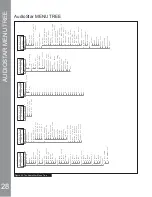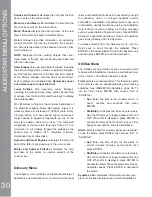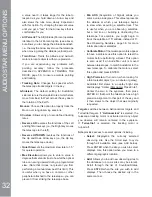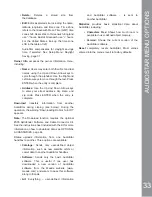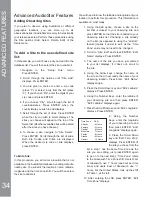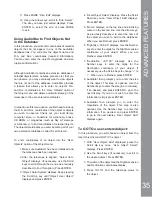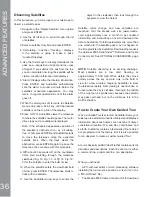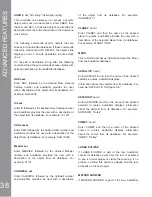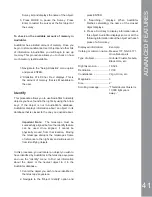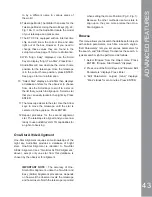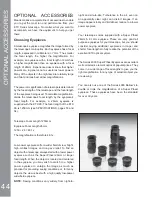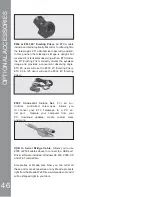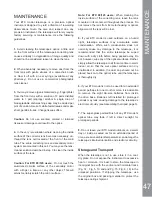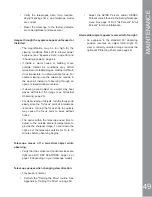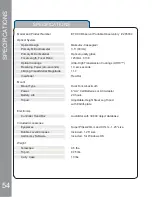
checks its database every time the tour is activated
to see if a meteor shower is visible that evening. If no
meteor shower is visible, this option is skipped and the
tour proceeds on to the next object.
DEEP SKY
“name”
Enter DEEP SKY followed by the name of the desired
object in quotes. For example:
DEEP SKY “Small Magellanic Cloud”
CONSTELLATION
“name”
Enter CONSTELLATION followed by the name of
the desired constellation in quotes. For example:
CONSTELLATION “Leo Major”
STAR
“name”
Enter STAR followed by the name of the desired star in
quotes. For example: STAR “Vega”
LANDMARK
az alt “title” “description”
Enter the azimuth (az) for the desired object in
the following format: xxxdxxmxxs. For example:
123d27m00s. Then enter the altitude of the desired
object in the following format: xxdxxmxxs. Then enter
the title string and description string in quotes. For
example:
LANDMARK 123d27m00s 57d20m20s “Landmark 1”
“North corner of apartment building”
PICK ONE / PICK END
These two statements are used to surround a list of
items that AudioStar can choose from during a tour.
AudioStar begins at the top of the PICK ONE list and
GLVSOD\VWKH¿UVWREMHFWIURPWKHOLVWWKDWLVDERYHWKH
horizon and ignores the rest.
This statement is useful for developing tours that can
be presented year round. For each object type you wish
to use to illustrate in your tour, pick 10 to 12 examples
spaced across the range of right ascension. Bracket
them by the PICK ONE / PICK END statements. One
current example displays for the user. For example:
AUTO SELECT TEXT
“Globular Cluster” “Globular
clusters are huge balls of stars”.
“They contain 50,000 to 100,000 stars and are located
on the fringes of our “galaxy”.
PICK ONE
AUTO SELECT MESSIER 13
AUTO SELECT MESSIER 15
AUTO SELECT MESSIER 92
AUTO SELECT MESSIER 4
AUTO SELECT MESSIER 68
AUTO SELECT NGC 1234
AUTO SELECT TEXT “None Available” “I’m sorry.
There are no bright globular” “clusters visible at
this time”.
PICK END
AUTO SLEW ON / AUTO SLEW OFF
With AUTO SLEW ON enabled in the tour, AudioStar
DXWRPDWLFDOO\ VOHZV WKH WHOHVFRSH WR REMHFWV ¿UVW
before displaying the text description. This feature
is useful when designing tours in which observing
certain objects is required. For example, an astronomy
professor may require his students to observe six
objects, four of which AudioStar automatically slews to
in a tour. The students would have to manually slew to
the last two objects. He would then place AUTO SLEW
21 EHIRUH KLV ¿UVW UHTXLUHG REMHFW DQG$872 6/(:
OFF after the fourth object.
#END
To end a tour, type the command #END on a separate
line at the very end of the tour.
Downloading Tours
2QFHDWRXULVZULWWHQDQGVWRUHGDVDQ$6&,,¿OHVDYHG
HLWKHUDVD³WH[WRQO\´RU³06'26WH[W´¿OHORDGLWLQWR
AudioStar using the AudioStar Update Utility on your PC.
As tours are downloaded into the handbox, AudioStar
ADV
A
NCED FEA
T
URES
39


